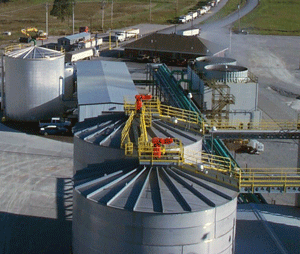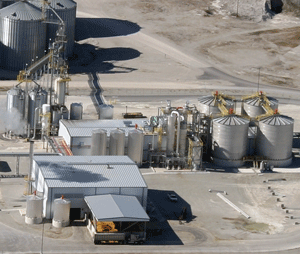On ‘Common' Ground





January 4, 2007
BY Dave Nilles
Western Kentuckians know a few things about grain-based alcohol production. After all, the James B. Beam Distilling Co. has been producing bourbon whisky in the region since 1795.
Despite centuries of distillation expertise, however, Kentucky hasn't produced much fuel ethanol, until recently. Although Commonwealth Agri-Energy may never take Jim Beam's place in the spotlight, the company is making its mark in the Bluegrass State.
Commonwealth Agri-Energy General Manager Mick Henderson came in on the ground floor when he was hired to manage Kentucky's only fuel ethanol plant. He joined the project as Fagen Inc. was pouring foundations for the plant. ICM Inc. supplied the process design that would produce 20 MMgy of ethanol.
At the time of the project's conception in 2001, a 20 MMgy ethanol plant wasn't uncommon, Henderson says. However, by the time construction began in April of 2003, VeraSun was already working on its first 100 MMgy dry-grind plant in South Dakota. "We looked miniscule," Henderson says.
However, Commonwealth's return on investment has been anything but miniscule, and the plant's investors are happily reaping its benefits. The project is 100 percent farmer-owned by members of the Hopkinsville Elevator Co-op and the Kentucky Corn Growers' Association (KCGA), both of which played an important role in the development of the project. In 2003, the KCGA invested $1 million in the project through its subsidiary Kentucky Corn Plus LLC. KCGA made the investment with hopes that the plant would create another market for Kentucky corn and thereby boost local corn prices. The project has clearly done that.
Commonwealth Agri-Energy, which is located along a CSX railroad main line adjacent to the co-op's Hopkinsville grain elevator, operated above its nameplate capacity for a year after it started producing in February of 2004. The plant was initially designed to expand to 30 MMgy of nameplate capacity. The managing board approved that expansion project and construction began in July of 2005, Henderson says. Robinson Construction Co. built the addition using an ICM design. The project was completed in mid-January of 2006 and boosted the plant's capacity to 33 MMgy.
The plant's expansion led to even more demand for corn in an area of Kentucky where the crop was already in great demand. With only about 70,000 acres of corn planted annually, the healthy cattle and poultry industries, along with the 12 million bushels of corn per year that Commonwealth required, put heavy pressure on corn production in Christian County. The result was higher local corn prices. While beneficial to area farmers, the high cost of corn posed a risk for the ethanol plant. When July 2007 corn futures briefly touched $4 a bushel earlier this year, Henderson says he had to pay $4.05 to $4.10 a bushel for corn due to a higher local corn basis.
Consequently, Commonwealth Agri-Energy has developed several strategies to lessen the impact created by the plant's most costly input.
For instance, the plant uses an adjacent 43-acre lake—formed in an abandoned limestone quarry—for process and cooling water. During a late November warm spell, 1,200 gallons of water per day were circulated from the 90-feet-deep lake to help cool the plant.
Commonwealth also maximizes its coproduct streams. Pain Enterprises built a carbon dioxide processing facility on five acres adjacent to the ethanol plant. Pain is expanding its plant to match the ethanol facility's carbon dioxide emissions, which Pain captures to produce dry ice.
Henderson says the plant has also been extracting corn oil from its distillers grains for approximately 18 months. Three truckloads per week, or roughly 1 MMgy, of the corn oil is used in animal feed. Although it doesn't have a major impact on the bottom line, "it might be the difference between staying in business—or not—with $4 corn," Henderson says.
Several other technological updates are being considered. Henderson says front-end corn dry fractionation would add a more diverse product line, including bran that could be used to fire a biomass boiler. The biomass boiler would displace the natural gas currently being used as an energy source. Other fuel sources are also being considered, including locally sourced wood chips and Kentucky coal.
Henderson says any infrastructure changes would be aimed at eventually including cellulosic ethanol production. "I'd like to have that infrastructure in place in the next three to five years," he says. "If the siting of the plant and infrastructure allow it, [cellulose] is a good venture to get into. If it's going to happen—and it should—that would be a good way to get our foot in the door."
Commonwealth is also hoping to squeeze into additional ethanol markets in the southeastern United States. Currently, most of the plant's ethanol, marketed by Ethanol Products, is shipped via truck to Louisville, Ky., and St. Louis, Mo. However, freight costs make Commonwealth less competitive with the newer plants going up near St. Louis.
Ethanol's entry into the Atlanta and Florida markets, which have mostly shunned the fuel, would likely boost the company's name recognition in the southeast—though still probably not enough to surpass Jim Beam.
More information on Commonwealth Agri-Energy LLC can be found at www.commonwealthagrienergy.com.
Despite centuries of distillation expertise, however, Kentucky hasn't produced much fuel ethanol, until recently. Although Commonwealth Agri-Energy may never take Jim Beam's place in the spotlight, the company is making its mark in the Bluegrass State.
Commonwealth Agri-Energy General Manager Mick Henderson came in on the ground floor when he was hired to manage Kentucky's only fuel ethanol plant. He joined the project as Fagen Inc. was pouring foundations for the plant. ICM Inc. supplied the process design that would produce 20 MMgy of ethanol.
At the time of the project's conception in 2001, a 20 MMgy ethanol plant wasn't uncommon, Henderson says. However, by the time construction began in April of 2003, VeraSun was already working on its first 100 MMgy dry-grind plant in South Dakota. "We looked miniscule," Henderson says.
However, Commonwealth's return on investment has been anything but miniscule, and the plant's investors are happily reaping its benefits. The project is 100 percent farmer-owned by members of the Hopkinsville Elevator Co-op and the Kentucky Corn Growers' Association (KCGA), both of which played an important role in the development of the project. In 2003, the KCGA invested $1 million in the project through its subsidiary Kentucky Corn Plus LLC. KCGA made the investment with hopes that the plant would create another market for Kentucky corn and thereby boost local corn prices. The project has clearly done that.
Commonwealth Agri-Energy, which is located along a CSX railroad main line adjacent to the co-op's Hopkinsville grain elevator, operated above its nameplate capacity for a year after it started producing in February of 2004. The plant was initially designed to expand to 30 MMgy of nameplate capacity. The managing board approved that expansion project and construction began in July of 2005, Henderson says. Robinson Construction Co. built the addition using an ICM design. The project was completed in mid-January of 2006 and boosted the plant's capacity to 33 MMgy.
The plant's expansion led to even more demand for corn in an area of Kentucky where the crop was already in great demand. With only about 70,000 acres of corn planted annually, the healthy cattle and poultry industries, along with the 12 million bushels of corn per year that Commonwealth required, put heavy pressure on corn production in Christian County. The result was higher local corn prices. While beneficial to area farmers, the high cost of corn posed a risk for the ethanol plant. When July 2007 corn futures briefly touched $4 a bushel earlier this year, Henderson says he had to pay $4.05 to $4.10 a bushel for corn due to a higher local corn basis.
Consequently, Commonwealth Agri-Energy has developed several strategies to lessen the impact created by the plant's most costly input.
For instance, the plant uses an adjacent 43-acre lake—formed in an abandoned limestone quarry—for process and cooling water. During a late November warm spell, 1,200 gallons of water per day were circulated from the 90-feet-deep lake to help cool the plant.
Commonwealth also maximizes its coproduct streams. Pain Enterprises built a carbon dioxide processing facility on five acres adjacent to the ethanol plant. Pain is expanding its plant to match the ethanol facility's carbon dioxide emissions, which Pain captures to produce dry ice.
Henderson says the plant has also been extracting corn oil from its distillers grains for approximately 18 months. Three truckloads per week, or roughly 1 MMgy, of the corn oil is used in animal feed. Although it doesn't have a major impact on the bottom line, "it might be the difference between staying in business—or not—with $4 corn," Henderson says.
Several other technological updates are being considered. Henderson says front-end corn dry fractionation would add a more diverse product line, including bran that could be used to fire a biomass boiler. The biomass boiler would displace the natural gas currently being used as an energy source. Other fuel sources are also being considered, including locally sourced wood chips and Kentucky coal.
Henderson says any infrastructure changes would be aimed at eventually including cellulosic ethanol production. "I'd like to have that infrastructure in place in the next three to five years," he says. "If the siting of the plant and infrastructure allow it, [cellulose] is a good venture to get into. If it's going to happen—and it should—that would be a good way to get our foot in the door."
Commonwealth is also hoping to squeeze into additional ethanol markets in the southeastern United States. Currently, most of the plant's ethanol, marketed by Ethanol Products, is shipped via truck to Louisville, Ky., and St. Louis, Mo. However, freight costs make Commonwealth less competitive with the newer plants going up near St. Louis.
Ethanol's entry into the Atlanta and Florida markets, which have mostly shunned the fuel, would likely boost the company's name recognition in the southeast—though still probably not enough to surpass Jim Beam.
More information on Commonwealth Agri-Energy LLC can be found at www.commonwealthagrienergy.com.
Advertisement
Advertisement
Upcoming Events





